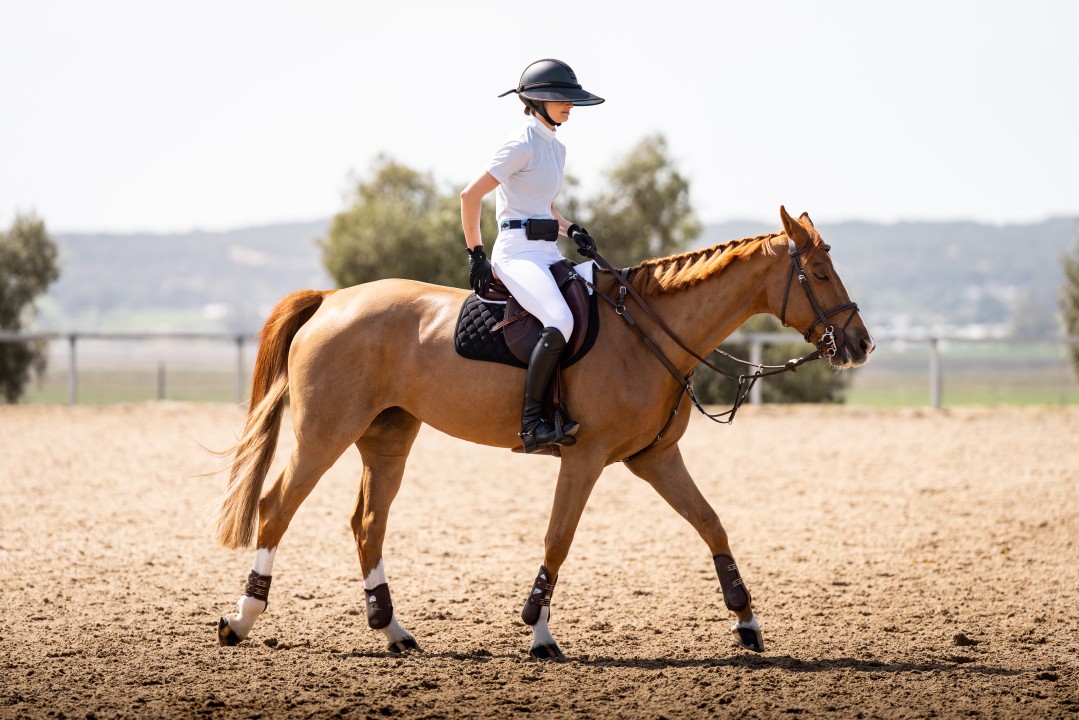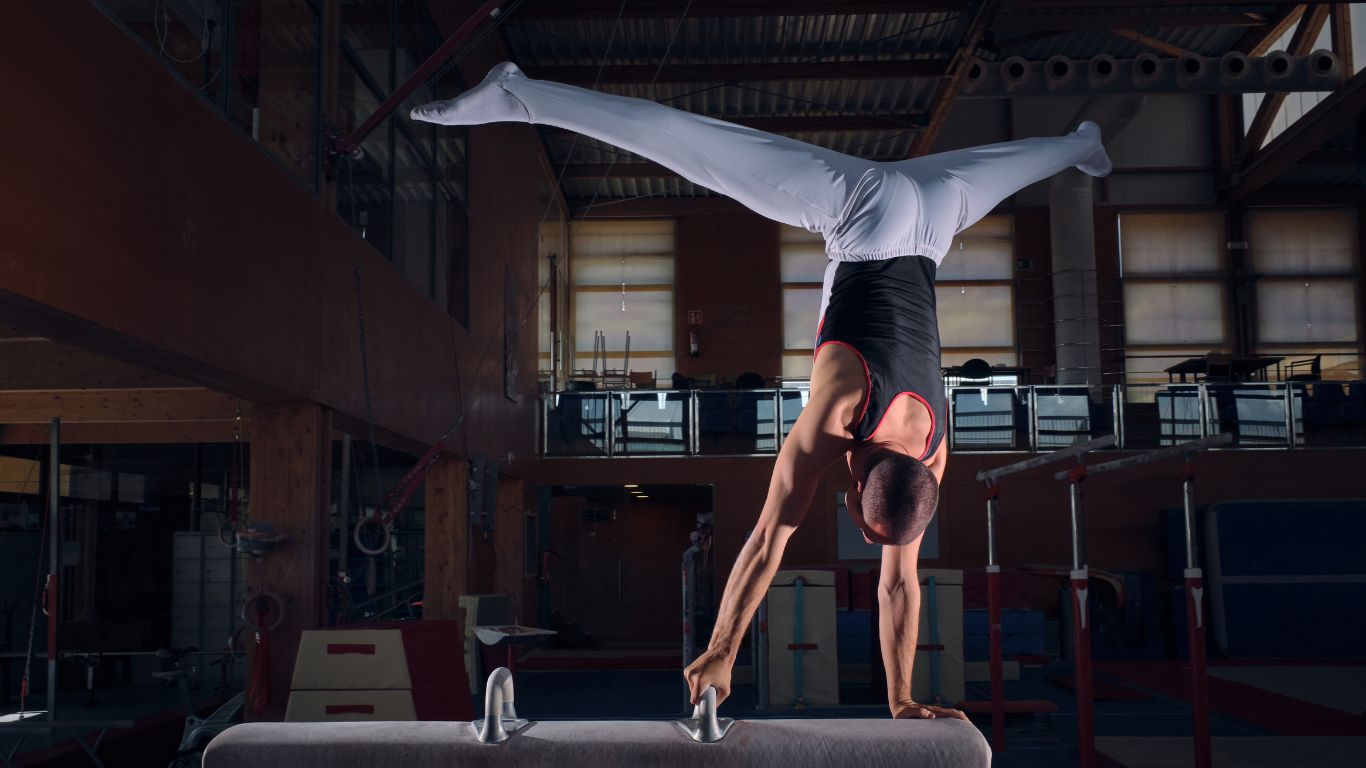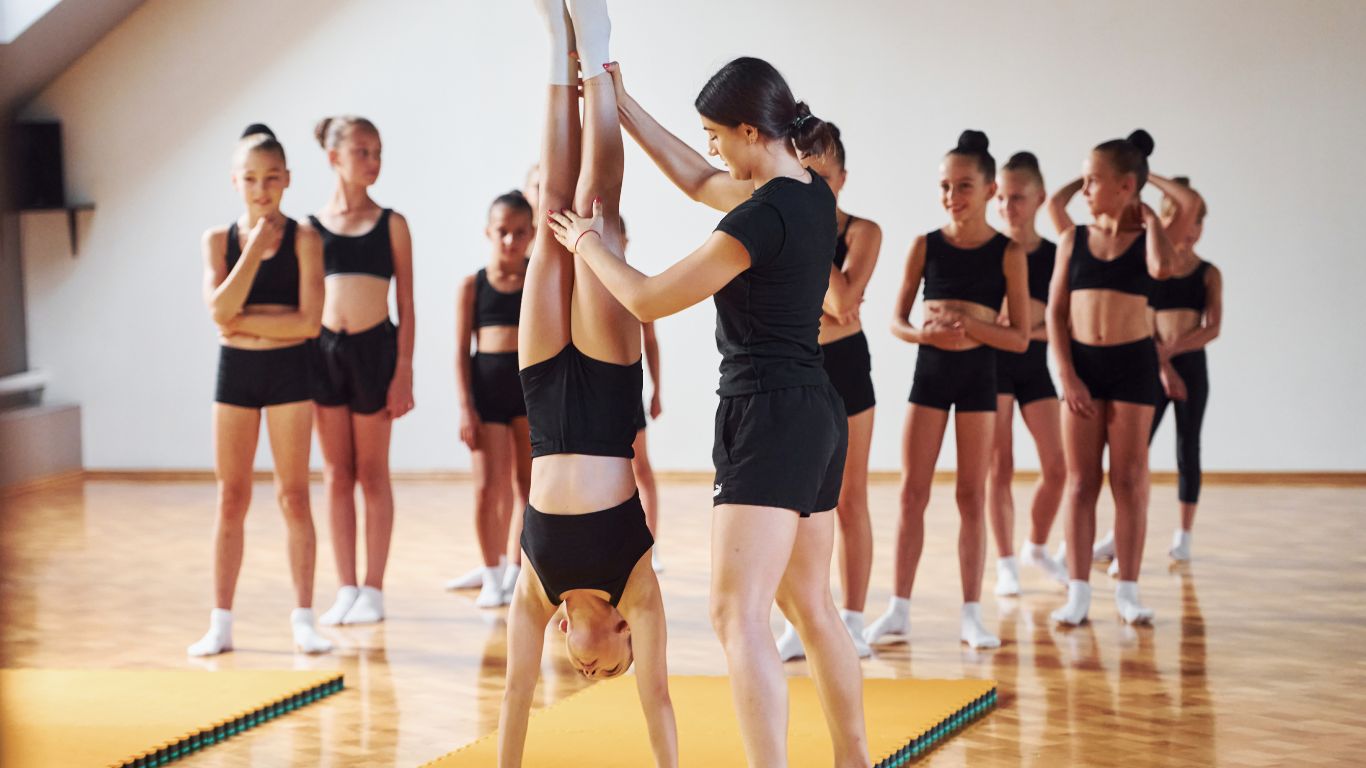Gymnasts are often short due to the biomechanical advantages gained from having a lower center of gravity, which allows for better balance and maneuverability. This physical trait is essential for performing intricate tumbling and acrobatic movements with precision and control.
Gymnasts come in a range of heights, but shorter stature is advantageous in the sport. The shorter limbs of a gymnast provide better control for complex movements and reduce the risk of injury during high-impact landings. Additionally, a smaller body size allows gymnasts to achieve greater rotational speed in mid-air, enhancing their performance.
While height is not the sole determinant of success in gymnastics, it can certainly offer specific advantages when combined with skill and determination. Understanding the natural advantages of shorter stature in gymnastics sheds light on why many elite athletes in the sport tend to be shorter in height.
The Role Of Genetics
The Influence Of Parents’ Height
Gymnasts’ height is greatly influenced by the height of their parents, as genetic predisposition plays a significant role in determining an individual’s stature. Children inherit genes from their parents, which directly influences their growth and development. If both parents are short in height, it is highly likely that their children will also have a shorter stature, which could be advantageous in the world of gymnastics.
Genetic Variations In Height
Genetic variations play a crucial role in determining an individual’s height. Human height is a complex trait influenced by numerous genes, each with a small effect. These genetic variations contribute to the diversity in human height and can explain why gymnasts tend to be shorter. It is believed that specific gene variants associated with shorter stature may be advantageous for certain physical activities, such as gymnastics, due to improved strength-to-weight ratio and enhanced agility.
The Impact Of Training At A Young Age
Gymnasts’ shorter stature is sometimes attributed to the impact of training at a young age. The intense and focused training regimen that young gymnasts undergo, particularly during their growth spurts, is believed to have a significant impact on their physical development, including their height. Let’s delve into whether this training stunts their growth or actually facilitates optimal development.
Stunting Growth or Optimal Development?
Stunting Growth Or Optimal Development?
Contrary to popular belief, intensive gymnastics training does not necessarily stunt growth. While it’s true that the intense physical activity can temporarily slow down the rate of growth during puberty, it’s often compensated by a period of accelerated growth once training intensity decreases. This pattern suggests that gymnasts may achieve their full adult height, indicating that the impact of gymnastics on growth is more complex than simply stunting it.
Benefits Of Starting Gymnastics Early
- Develops strong and flexible bodies
- Enhances balance and coordination
- Instills discipline and perseverance
- Promotes confidence and self-esteem
- Allows for early identification of talent
The Effects Of Intensive Training
The effects of intensive training on gymnasts have led to their shorter stature. This is a result of their bodies adapting to the demands and requirements of the sport, which emphasize strength, flexibility, and agility. As a result, gymnasts often have compact builds that enable them to perform incredible feats of athleticism.
Training Regimes And Growth Plates
Intensive training in gymnastics can have a significant impact on the growth plates of young athletes. Growth plates are areas of developing cartilage found at the ends of long bones in children and adolescents. They are responsible for bone growth and development. The repetitive and high-impact movements performed in gymnastics training put excessive stress on these growth plates, potentially affecting their growth and leading to a shorter stature.
In gymnastics, athletes start training at a young age when their bodies are still growing and developing. The intense training regimes, which include rigorous practice sessions for hours every day, place a tremendous amount of stress on their bodies.
This is particularly true for activities that involve jumping, tumbling, and flipping, where gymnasts often land on hard surfaces like mats. The repetitive impact and pressure on the growth plates during these exercises can cause them to close earlier than in non-gymnasts, leading to a reduced potential for bone growth.
Besides the excessive stress on growth plates, the physical demands of gymnastics can also cause micro-fractures in bones. These fractures, although usually not severe, can further hinder growth and contribute to a shorter stature in gymnasts. The repeated loading and unloading of bones during training can potentially disrupt the normal process of ossification, leading to compromised bone growth.
The Role Of Hormones In Height
An additional factor that contributes to the shorter stature of gymnasts is the role of hormones in height development. Puberty, a period of significant growth, plays a crucial role in determining an individual’s final height. However, the intense training and physical demands of gymnastics can delay puberty and disrupt the hormonal balance in young athletes, affecting their growth spurts.
The stress and energy expenditure associated with gymnastics training can disrupt the normal production of hormones such as growth hormone, insulin-like growth factor 1 (IGF-1), and estrogen. These hormones are crucial for bone growth and maturation during puberty. When the hormonal balance is disrupted, it can lead to delayed bone growth and development, ultimately resulting in shorter stature.
Furthermore, the intensive training regimes in gymnastics can also lead to decreased levels of body fat. This low body fat percentage can also impact hormone production, as hormones are synthesized from cholesterol, a component of fat. Reduced hormone levels can affect the growth and development of bones, contributing to a shorter height in gymnasts.
The Importance Of Body Proportions
Among the many factors that contribute to a gymnast’s success, body proportions play a crucial role. Gymnastics demands a unique combination of strength, flexibility, and agility. Often wondered why gymnasts are shorter than average? The answer lies in how their compact physique provides them with distinct advantages in their sport.
Limb Length And Competitive Advantage
Gymnasts are typically shorter in stature due to the fact that they have shorter limbs compared to individuals in other sports. This characteristic gives them a distinct competitive advantage, enabling them to perform intricate and powerful moves with relative ease. Let’s delve into some key reasons why their specific limb length plays a crucial role in their success:
- Enhanced Power and Control: Gymnasts’ shorter limbs enable them to generate greater power and control over their movements. With a lower center of gravity, they are better equipped to perform explosive maneuvers, such as flips, jumps, and spins, with incredible precision.
- Reduced Moment of Inertia: The shorter length of a gymnast’s limbs leads to a reduced moment of inertia. This means they are able to manipulate their bodies more efficiently, enabling faster rotations and transitions between different skills. Their ability to control their body in mid-air is amplified by the compactness of their physique.
- Increased Flexibility: Smaller limbs provide gymnasts with an increased range of motion, making it easier for them to achieve the necessary flexibility required for advanced gymnastic routines. Their shorter limbs minimize the strain on their muscles and joints, allowing them to execute intricate poses and movements with grace.
Understanding Gymnasts’ Compact Physique
The compact physique of gymnasts entails more than just their shorter limbs. It encompasses a multitude of other physical attributes that contribute to their success in the sport. Some notable elements include:
- Muscular Build: Gymnasts often possess a prominently muscular build, characterized by well-defined muscles. This muscularity aids in their ability to generate power and execute precise movements.
- Strong Core: A strong core is essential for maintaining body control and balance during various gymnastic routines. The compact physique of gymnasts provides them with a naturally strong core, crucial for their exceptional stability.
- Lightweight Frame: Maintaining a lightweight body is crucial for gymnasts as it allows them to perform gravity-defying moves effortlessly. Their compact physique helps them achieve a lean and agile body that facilitates their exceptional athletic performance.
The Psychological Aspect
Gymnastics is a sport that demands not only physical strength and agility but also mental prowess. While it’s commonly known that gymnasts tend to be shorter in stature, the reasons behind this phenomenon go beyond mere genetics. In fact, the psychological aspect plays a significant role in the height of gymnasts.
The Impact Of Psychological Factors On Height
Psychological factors such as self-selection, motivation, and the coach’s influence can contribute to the shorter stature observed in gymnasts. Let’s explore each of these factors in greater detail:
The Selection Process For Gymnastics
When it comes to selecting candidates for gymnastics, certain physical characteristics are favored. Coaches often prioritize athletes with a shorter stature due to the sport’s technical demands. The center of gravity is lower in shorter individuals, allowing for enhanced balance, quicker rotations, and better maneuverability. This preference for shorter gymnasts is ingrained in the selection process and influences the overall height norms in the sport.
A study conducted by Johnson and Huitema in 1970 analyzed the relationship between height and performance in female gymnasts. They found that the most successful athletes tended to have shorter heights compared to those at lower skill levels. These findings further support the notion that a shorter stature provides an advantage in gymnastics.
Moreover, gymnasts often start training at a very young age when their bodies are still developing. Intensive training from a young age can affect the growth plates, which are responsible for the overall height of an individual. As a result, engaging in gymnastics at a young age can potentially stunt growth and lead to shorter stature.
Influences From Coaches And Peers
The psychological aspect extends to the influence of coaches and peers in the world of gymnastics. Coaches play a pivotal role in shaping an athlete’s mindset, instilling discipline, and fueling motivation. Gymnasts receive constant guidance from their coaches, who aim to optimize their performance in every aspect, including their physique.
Coaches often emphasize the importance of maintaining a lean and compact body shape, which is believed to enhance performance in gymnastics. Due to these expectations, gymnasts may experience additional pressure to conform to a certain body type, potentially leading to a preference for shorter individuals who naturally possess the desired attributes.
Furthermore, the influence of peers cannot be discounted. Gymnasts often train and compete alongside fellow athletes who fall within the same height range. This shared experience and camaraderie among competitors can contribute to a sense of belonging and motivation within the gymnastics community, reinforcing the idea that being shorter is an advantage in the sport.

Credit: www.linkedin.com
Nutrition And Weight Management
Gymnasts tend to be shorter due to factors like training at a young age, genetics, and the benefits of having a low center of gravity for rotational movements. Their focus on nutrition and weight management also plays a role in maintaining their compact physique for optimal performance.
The Relationship Between Diet And Height
Proper nutrition plays a crucial role in the growth and development of individuals, including gymnasts. Gymnasts have unique dietary needs that are carefully designed to support their athletic performance and maintain their ideal weight. Strikingly, the height of gymnasts tends to be shorter compared to individuals in other sports, and this can be attributed to several factors.
A gymnast’s diet is carefully crafted to provide the necessary nutrients for physical activity while keeping a balance in weight management. The emphasis is on consuming nutrient-dense foods that support energy levels and maintain overall health. Here are several key aspects of the diet that influence height:
Balancing Weight And Athletic Performance
Gymnasts often require a certain body weight and body composition to excel in their sport. This weight management is achieved through a combination of diet and training. By closely monitoring their calorie intake and the types of food they eat, gymnasts are able to maintain the desired weight while still performing at their peak.
Avoiding excessive weight gain is crucial for gymnasts as it can affect their ability to perform certain acrobatic moves effectively. By staying within a specific weight range, gymnasts gain an advantage in terms of strength-to-weight ratio, allowing them to execute intricate routines with precision and agility.
To achieve this balance, gymnasts often follow a dietary plan that includes a combination of carbohydrates, proteins, and fats. Carbohydrates provide the energy needed for the intense workouts, while proteins support muscle repair and growth. Healthy fats, such as those found in avocados and nuts, are essential for hormone production and overall well-being.
Another factor in weight management is fluid intake. Proper hydration is crucial for gymnasts to maintain their energy levels during training and competitions. Dehydration can have a negative impact on performance and overall health. Gymnasts are encouraged to drink enough water throughout the day and replenish electrolytes lost through sweat.
Overall, gymnasts strike a delicate balance between weight management and athletic performance. Their diet is carefully tailored to provide the necessary nutrients while maintaining their desired physique, which inevitably influences their height.
The Influence Of Nutrition On Growth
While nutrition plays a vital role in fueling a gymnast’s performance, it also has an impact on their height. During the growth years, inadequate nutrition can stunt overall growth and lead to a shorter stature. However, it is important to note that genetics also play a significant role in determining an individual’s height.
Gymnastic training, particularly in the early years when bones are still growing, can place stress on the body. Proper nutrition is essential to support bone health and minimize the risk of injury. This is why gymnasts often incorporate calcium-rich foods, such as dairy products, into their diet. Calcium is crucial for bone development and strength.
Gymnasts also consume foods rich in vitamins and minerals that aid in growth and development. Vitamins A, C, D, and E are particularly important for bone health and immune system function. Additionally, minerals like magnesium and zinc play a role in muscle function and recovery.
Overall, a well-rounded diet that includes a variety of nutrient-dense foods is crucial for the growth and development of gymnasts. It not only supports their athletic performance but also helps maintain their ideal weight while ensuring proper bone health and overall well-being.
Injury Prevention And Growth
Gymnasts are often shorter due to various factors, including genetics, intense training from a young age, and the impact of gymnastics on their bodies. In this section, we’ll explore the correlation between injury prevention and growth in gymnasts.
The Effects Of Injuries On Growth
Injuries can significantly impact the growth of young gymnasts. The stress placed on the body during training and the high-impact nature of the sport can lead to injuries that may affect bone development. Factors such as stress fractures and joint injuries can hinder overall growth potential in gymnasts.
Strategies For Minimizing Injuries
Proper conditioning and strengthening exercises play a crucial role in preventing injuries among gymnasts. Additionally, maintaining a healthy diet that supports bone health and overall growth is essential. Regular monitoring and assessment by qualified coaches and medical professionals can also help identify and address potential issues before they escalate.

Credit: goaugie.com
The Influence Of Cultural Factors
Gymnasts’ short stature has often sparked curiosity, leading many to wonder about the influence of cultural factors. Let’s dive into the pivotal role that cultural preferences and pioneering success stories of short gymnasts have played in shaping the gymnastics landscape.
Cultural Preferences And Gymnast Size
Cultural preferences have significantly influenced the ideal body type for gymnasts. In certain cultures, there is a preference for athletes with petite and compact physiques, as these traits are believed to enhance agility, flexibility, and rotational movements. This emphasis on small and nimble athletes has contributed to the prominence of shorter gymnasts within the sport.
The Pioneering Success Stories Of Short Gymnasts
Despite their diminutive stature, numerous short gymnasts have achieved remarkable success, debunking the notion that height is a limiting factor in gymnastics. Athletes like Simone Biles and Shawn Johnson have shattered records and captivated audiences, serving as inspirational figures for aspiring gymnasts of all heights. Their triumphs have reshaped the perception of what is achievable in gymnastics, emphasizing skill and determination over height.
Ethical Considerations
When it comes to the height of gymnasts, ethical considerations play a significant role. The debate surrounding optimal training methods and promoting healthy development in gymnasts has attracted attention from experts in the field. Let’s delve deeper into these crucial aspects and understand how they impact the height of gymnasts.
The Debate On Optimal Training Methods
Gymnastics is a highly demanding sport that requires an immense amount of dedication, discipline, and training. The debate centers around the intensity and duration of training sessions, which may vary between gymnastic programs and coaches. Some argue that early and intense training can stunt the growth of gymnasts, leading to a shorter stature. However, others believe that a focused and structured training regime is necessary to excel in the sport.
While there isn’t a one-size-fits-all answer to this debate, it’s important to consider the long-term effects of intense training on the developing bodies of young gymnasts. Overtraining can lead to physical strain and potential injuries that may hinder healthy growth. Striking the right balance between training and rest is crucial to ensure the overall growth and well-being of gymnasts.
Promoting Healthy Development In Gymnasts
Gymnastics organizations and coaches are increasingly putting emphasis on promoting healthy development in gymnasts. The focus has shifted from solely achieving competitive success to ensuring the overall well-being of athletes. This includes allowing adequate time for rest, implementing proper nutrition plans, and emphasizing injury prevention techniques.
Coaches and gymnastics organizations now recognize the importance of age-specific training programs that respect the individual growth and development of gymnasts. This approach takes into account the physical maturity of gymnasts, allowing them to progress at a pace suitable for their bodies. By prioritizing healthy development, gymnasts have a better chance of reaching their full potential without compromising their overall growth.
It’s crucial for trainers, coaches, and parents to understand the ethical considerations involved in the training of gymnasts. This not only includes ensuring their physical well-being but also their mental health and emotional support. By providing a supportive and nurturing environment, gymnasts can flourish without sacrificing their growth potential.
The Future Of Gymnastics
Gymnasts tend to be shorter due to the advantage of having a lower center of gravity, enhancing their stability and agility during performances. This inherent advantage helps them execute complex moves with precision and grace, making height less of a priority in the world of gymnastics.
Evolution Of Gymnastics And Height
Gymnastics has come a long way in its evolution, and one significant aspect that has sparked curiosity is the height of gymnasts. It is a common observation that gymnasts tend to be shorter compared to athletes in other sports. While height was once perceived as a disadvantage, the future of gymnastics might see a shift in this notion.
Potential Changes In Training And Selection Processes
In order to adapt and excel in the future of gymnastics, potential changes in training and selection processes can be considered. The emphasis on height might become less rigid, taking into account other crucial factors such as coordination, flexibility, and strength. This shift could open doors for athletes of various heights to participate and thrive in the sport.

Credit: www.espn.com
Frequently Asked Questions
Why Are Most Female Gymnasts Short?
Female gymnasts are typically short due to genetic factors and the biomechanical advantages of having a lower center of gravity. This helps with balance and agility, important in gymnastics. Training often begins at a young age, further influencing their growth.
Do Female Gymnasts Stunt Their Growth?
Female gymnasts do not stunt their growth. Although intense training can delay puberty, once it occurs, growth resumes. Gymnastics provides numerous benefits including strength, flexibility, and discipline. It is important to train under proper guidance to prevent injuries and ensure healthy development.
Do You Get Short If You Do Gymnastics?
Yes, gymnastics can make you shorter. The repetitive stress on the spine can compress the vertebrae, leading to a slight decrease in height over time.
Why Do You Have To Be Short To Be A Gymnast?
Being short is beneficial for gymnasts because it allows them to have a lower center of gravity, making it easier for them to balance and control their movements. Additionally, shorter limbs help gymnasts perform intricate and precise routines with greater agility and efficiency.
Conclusion
The height of gymnasts is influenced by various factors, including genetics and the demands of the sport. Their shorter stature provides them with advantages in terms of strength, flexibility, and stability. While being short may limit their performance in other sports, gymnastics is a perfect fit for their unique physical attributes.
So the next time you watch these incredible athletes in action, remember that their short stature is actually an advantage in the world of gymnastics.









